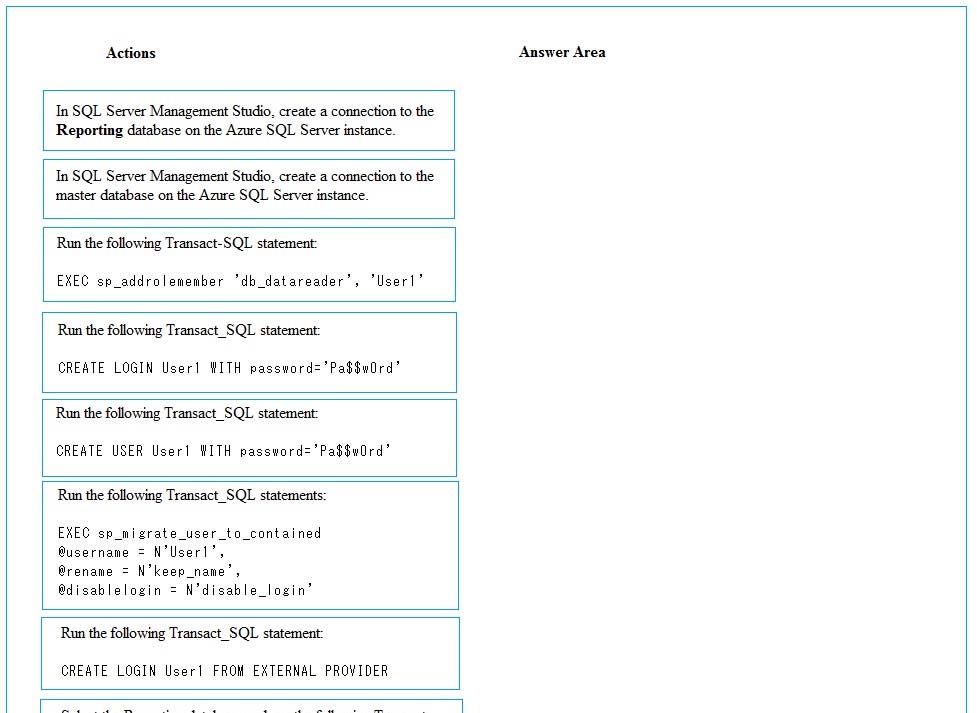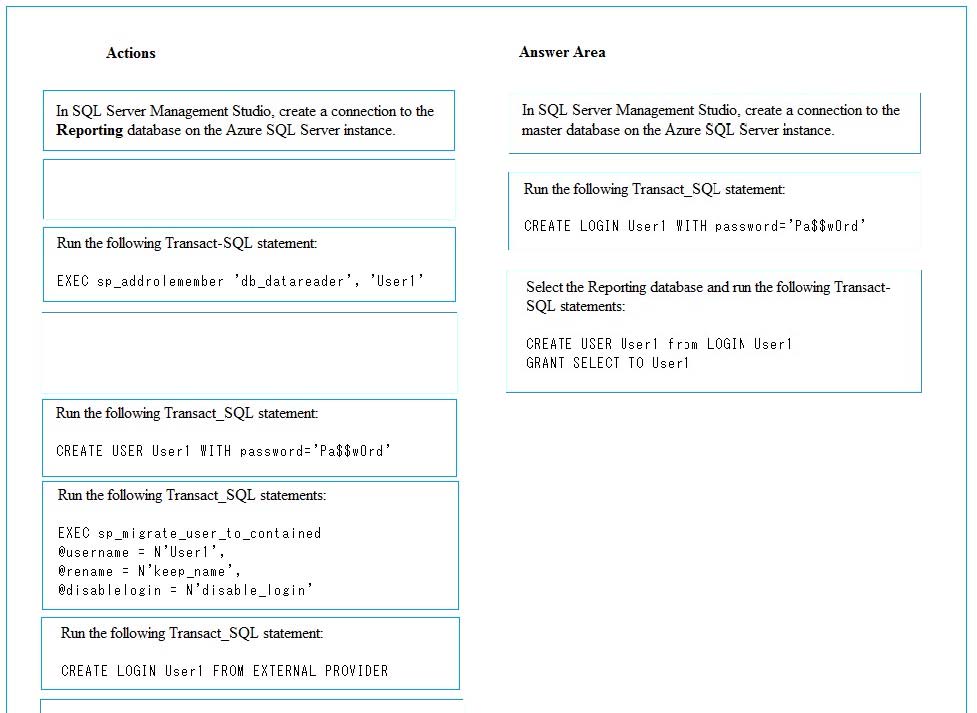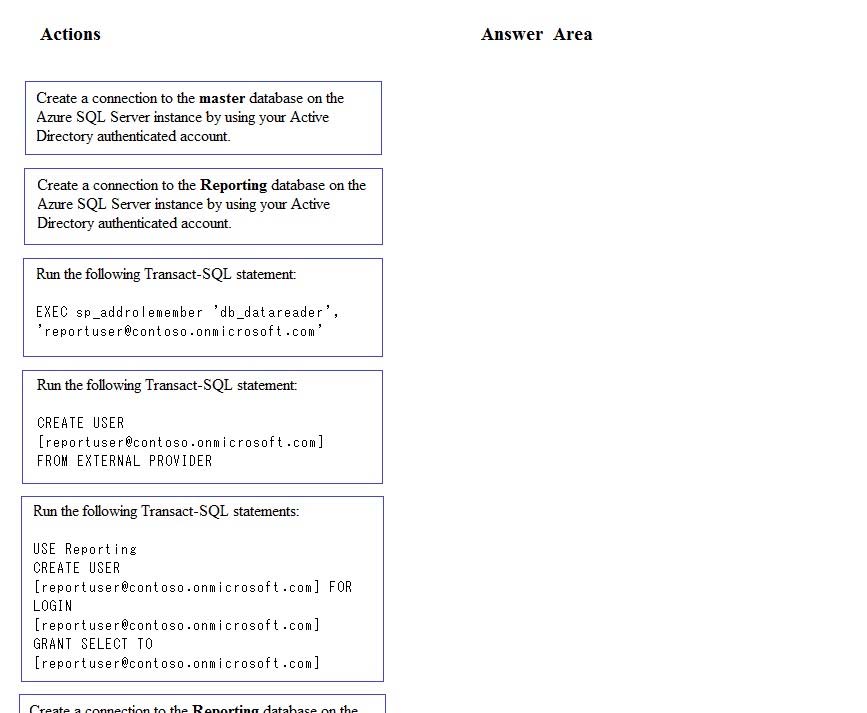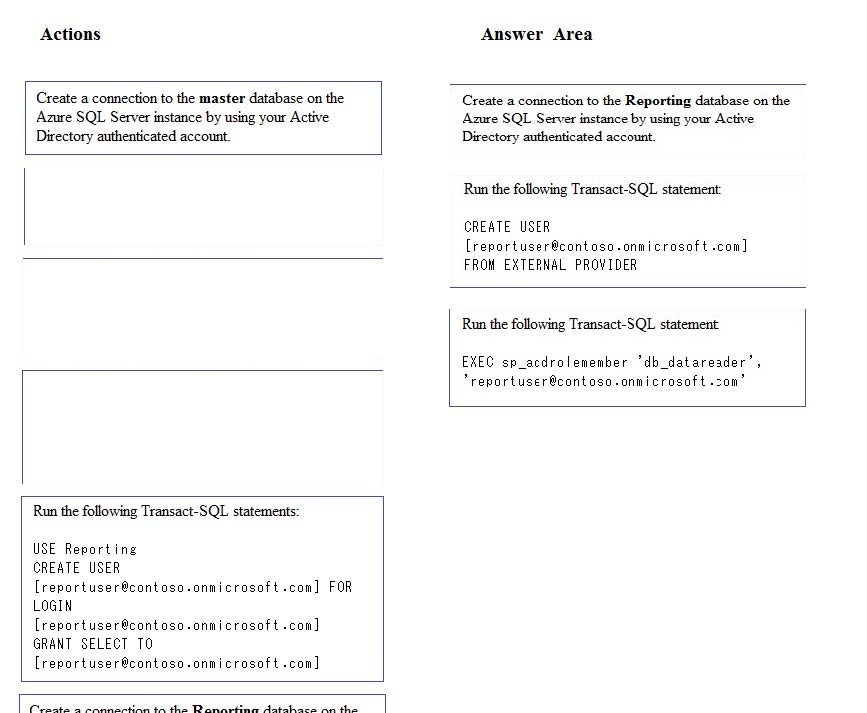Microsoft 70-765 Exam Practice Questions (P. 5)
- Full Access (186 questions)
- Six months of Premium Access
- Access to one million comments
- Seamless ChatGPT Integration
- Ability to download PDF files
- Anki Flashcard files for revision
- No Captcha & No AdSense
- Advanced Exam Configuration
Question #21
Note: This questions is part of a series of questions that use the same or similar answer choices. An answer choice may be correct for more than one question in the series. Each question is independent of the other questions in this series. Information and details provided in a question apply only to that question.
You deploy Microsoft SQL Server to a virtual machine in Azure. You distribute the database files and filegroups across multiple Azure storage disks.
You must be able to manage the databases as individual entities by using SQL Server Management Studio. All data in the databases must be stored encrypted.
Backups must be encrypted by using the same key as the live copy of the database.
You need to secure the data.
What should you implement?
You deploy Microsoft SQL Server to a virtual machine in Azure. You distribute the database files and filegroups across multiple Azure storage disks.
You must be able to manage the databases as individual entities by using SQL Server Management Studio. All data in the databases must be stored encrypted.
Backups must be encrypted by using the same key as the live copy of the database.
You need to secure the data.
What should you implement?
- Atransport-level encryption
- Bcell-level encryption
- CTransparent Data Encryption
- DAlways Encrypted
- EEncrypting File System
- FBitLocker
- Gdynamic data masking
Correct Answer:
C
Transparent data encryption (TDE) encrypts your databases, associated backups, and transaction log files at rest without requiring changes to your applications.
TDE encrypts the storage of an entire database by using a symmetric key called the database encryption key. In SQL Database the database encryption key is protected by a built-in server certificate. The built-in server certificate is unique for each SQL Database server.
References:
https://msdn.microsoft.com/en-us/library/dn948096.aspx
C
Transparent data encryption (TDE) encrypts your databases, associated backups, and transaction log files at rest without requiring changes to your applications.
TDE encrypts the storage of an entire database by using a symmetric key called the database encryption key. In SQL Database the database encryption key is protected by a built-in server certificate. The built-in server certificate is unique for each SQL Database server.
References:
https://msdn.microsoft.com/en-us/library/dn948096.aspx
send
light_mode
delete
Question #22
DRAG DROP -
You deploy a new Microsoft Azure SQL Database instance to support a variety of mobile applications and public websites. You plan to create a new security principal named User1.
The principal must have access to select all current and future objects in a database named Reporting. The activity and authentication of the database user must be limited to the Reporting database.
You need to create the new security principal.
Which three actions should you perform in sequence? To answer, move the appropriate actions from the list of actions to the answer area and arrange them in the correct order.
Select and Place:

You deploy a new Microsoft Azure SQL Database instance to support a variety of mobile applications and public websites. You plan to create a new security principal named User1.
The principal must have access to select all current and future objects in a database named Reporting. The activity and authentication of the database user must be limited to the Reporting database.
You need to create the new security principal.
Which three actions should you perform in sequence? To answer, move the appropriate actions from the list of actions to the answer area and arrange them in the correct order.
Select and Place:

Correct Answer:

Step 1, Step 2:
First you need to create a login for SQL Azure, it's syntax is as follows:
CREATE LOGIN username WITH password='password';
This command needs to run in master db. Only afterwards can you run commands to create a user in the database.
Step 3:
Users are created per database and are associated with logins. You must be connected to the database in where you want to create the user. In most cases, this is not the master database. Here is some sample Transact-SQL that creates a user:
CREATE USER readonlyuser FROM LOGIN readonlylogin;
References:
https://azure.microsoft.com/en-us/blog/adding-users-to-your-sql-azure-database/

Step 1, Step 2:
First you need to create a login for SQL Azure, it's syntax is as follows:
CREATE LOGIN username WITH password='password';
This command needs to run in master db. Only afterwards can you run commands to create a user in the database.
Step 3:
Users are created per database and are associated with logins. You must be connected to the database in where you want to create the user. In most cases, this is not the master database. Here is some sample Transact-SQL that creates a user:
CREATE USER readonlyuser FROM LOGIN readonlylogin;
References:
https://azure.microsoft.com/en-us/blog/adding-users-to-your-sql-azure-database/
send
light_mode
delete
Question #23
DRAG DROP -
A new Azure Active Directory security principal named [email protected] should have access to select all current and future objects in the
Reporting database. You should not grant the principal any other permissions. You should use your Active Directory Domain Services (AD DS) account to authenticate to the Azure SQL database.
You need to create the new security principal.
Which three actions should you perform in sequence? To answer, move the appropriate actions from the list of actions to the answer area and arrange them in the correct order.
Select and Place:

A new Azure Active Directory security principal named [email protected] should have access to select all current and future objects in the
Reporting database. You should not grant the principal any other permissions. You should use your Active Directory Domain Services (AD DS) account to authenticate to the Azure SQL database.
You need to create the new security principal.
Which three actions should you perform in sequence? To answer, move the appropriate actions from the list of actions to the answer area and arrange them in the correct order.
Select and Place:

Correct Answer:

Step 1:
To provision an Azure AD-based contained database user (other than the server administrator that owns the database), connect to the database (here the
Reporting database) with an Azure AD identity (not with a SQL Server account) that has access to the database.
Step 2: CREATE USER ... FROM EXTERNAL PROVIDER
To create an Azure AD-based contained database user (other than the server administrator that owns the database), connect to the database with an Azure AD identity, as a user with at least the ALTER ANY USER permission. Then use the following Transact-SQL syntax:
CREATE USER <Azure_AD_principal_name>
FROM EXTERNAL PROVIDER;
Step 3:
Grant the proper reading permissions.
References:
https://docs.microsoft.com/en-us/azure/sql-database/sql-database-aad-authentication

Step 1:
To provision an Azure AD-based contained database user (other than the server administrator that owns the database), connect to the database (here the
Reporting database) with an Azure AD identity (not with a SQL Server account) that has access to the database.
Step 2: CREATE USER ... FROM EXTERNAL PROVIDER
To create an Azure AD-based contained database user (other than the server administrator that owns the database), connect to the database with an Azure AD identity, as a user with at least the ALTER ANY USER permission. Then use the following Transact-SQL syntax:
CREATE USER <Azure_AD_principal_name>
FROM EXTERNAL PROVIDER;
Step 3:
Grant the proper reading permissions.
References:
https://docs.microsoft.com/en-us/azure/sql-database/sql-database-aad-authentication
send
light_mode
delete
Question #24
You are deploying a Microsoft SQL Server database that will support a mixed OLTP and OLAP workload. The target virtual machine has four CPUs.
You need to ensure that reports do not use all available system resources.
What should you do?
You need to ensure that reports do not use all available system resources.
What should you do?
- AIncrease the default database file auto growth sizes.
- BIncrease the value for the Minimum System Memory setting.
- CSet MAXDOP to half the number of CPUs available.
- DIncrease the value for the Minimum Memory per query setting.
Correct Answer:
C
When an instance of SQL Server runs on a computer that has more than one microprocessor or CPU, it detects the best degree of parallelism, that is, the number of processors employed to run a single statement, for each parallel plan execution. You can use the max degree of parallelism option to limit the number of processors to use in parallel plan execution.
Incorrect Answers:
A: The Auto Close property exposes server behavior for databases not accessed by a user. This feature will be removed in a future version of Microsoft SQL
Server. Avoid using this feature in new development work, and plan to modify applications that currently use this feature.
References:
https://msdn.microsoft.com/en-us/library/ms189094.aspx
C
When an instance of SQL Server runs on a computer that has more than one microprocessor or CPU, it detects the best degree of parallelism, that is, the number of processors employed to run a single statement, for each parallel plan execution. You can use the max degree of parallelism option to limit the number of processors to use in parallel plan execution.
Incorrect Answers:
A: The Auto Close property exposes server behavior for databases not accessed by a user. This feature will be removed in a future version of Microsoft SQL
Server. Avoid using this feature in new development work, and plan to modify applications that currently use this feature.
References:
https://msdn.microsoft.com/en-us/library/ms189094.aspx
send
light_mode
delete
Question #25
A company has an on-premises Microsoft SQL Server 2014 environment. The company has a main office in Seattle, and remote offices in Amsterdam and Tokyo.
You plan to deploy a Microsoft Azure SQL Database instance to support a new application. You expect to have 100 users from each office.
In the past, users at remote sites reported issues when they used applications hosted at the Seattle office.
You need to optimize performance for users running reports while minimizing costs.
What should you do?
You plan to deploy a Microsoft Azure SQL Database instance to support a new application. You expect to have 100 users from each office.
In the past, users at remote sites reported issues when they used applications hosted at the Seattle office.
You need to optimize performance for users running reports while minimizing costs.
What should you do?
- AImplement an elastic pool.
- BImplement a standard database with readable secondaries in Asia and Europe, and then migrate the application.
- CImplement replication from an on-premises SQL Server database to the Azure SQL Database instance.
- DDeploy a database from the Premium service tier.
Correct Answer:
B
References:
https://docs.microsoft.com/en-us/azure/sql-database/sql-database-geo-replication-transact-sql#add-secondary-database
B
References:
https://docs.microsoft.com/en-us/azure/sql-database/sql-database-geo-replication-transact-sql#add-secondary-database
send
light_mode
delete
All Pages
